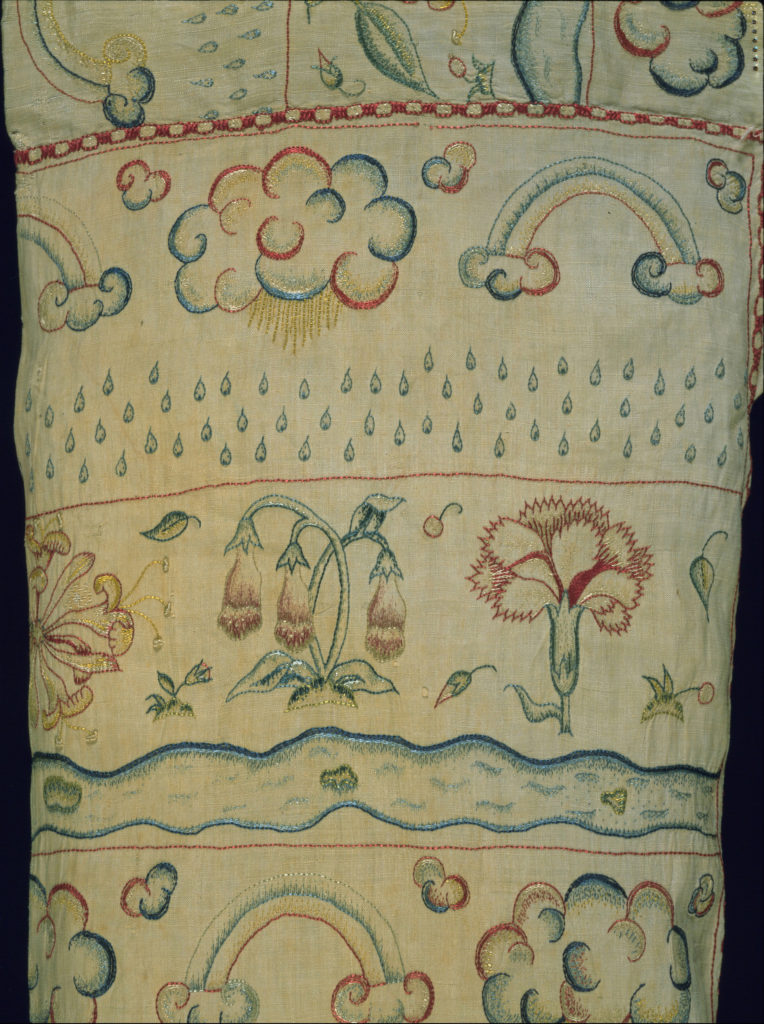Carnations, foxgloves, and honeysuckle are standard motifs in Tudor and Stuart embroidery (also seen, for example, on a coif in the Burrell Collection, Glasgow: http: //collections.glasgowmuseums.com/mweb cgi/mweb?request=record;id=36139; type=101#). They are very finely worked using mainly stem, satin and speckling stitches. The subtle colour gradations create a naturalistic, shaded effect, highlighted by the sheen of the silk threads.
Other motifs on the smock – the rainbows, clouds, raindrops and running water – are more unexpected. A man’s cap from the period in the Cooper Hewitt, Smithsonian Design Museum, New York is embroidered with rainbows and caterpillars, a combination that curators have suggested encapsulates a political message, alluding to the peace and transformation wrought upon the country by Queen Elizabeth I (https://collection.cooperhewitt.org/objects/18445161/). The flowers and meteorological designs on the Whitworth smock do not appear to have emblematic associations, yet they are apt in the context of sixteenth- and seventeenth-century ideas on the role of linen undergarments.
In his handbook On Good Manners for Children, first published in 1530, Desiderius Erasmus famously wrote that ‘clothing is, in a sense, the body of the body’, suggesting that dress was an extension of the body. The relationship between the two was even more closely intertwined than today, partly due to ideas about health, hygiene and the importance of maintaining the correct balance of the body’s humours. It was thought that dress had an active impact upon the wearer, protecting or sometimes even infecting the body. Therefore clothing could have therapeutic or toxic properties and, in this respect, dress itself could be considered to be a ‘foreign body’.
One of the functions of an undergarment like this smock was to draw sweat and impurities away from the body and various contemporary authors mused on the consequences of wearing dirty or clean linens. Doctor Bailey’s Directions for Health, Naturall and Artificiall (1633) describes how ‘the nastiness of servants, which neglect to ayre and brush such cloathes as they have in their custody, doe ingender a venomous vapour in some close or narrow corner’. In contrast, Bernardino Ramazzini in his book on occupational illnesses, De Morbis (first published in Italy in 1700), suggested that wearing a dirty smock actually fortified the wearer, as ‘foul linens strengthen you in a fever’.
It was thought that clothing could contaminate the air and spread sickness, so that garments worn by plague victims were burnt in case they harboured disease. Fragrant flowers, like the ones embroidered on the smock, might be used to improve the quality of the surrounding air. For the same reason, stronger perfumes such as musk and amber were sometimes added to clothing. Another Italian physician, Castore Durante, suggested in his Tesoro di Sanità (1586) that such scents could give ‘vigour to the brain’.
A further vital aspect of preserving good health was the regulation of body heat. It is possible that such a decorative smock would have been reserved for daywear but long linen garments like this were also worn in bed, together with a linen nightcap. Night time was a critical part of the day, when the sleeping body was more vulnerable. It was crucial to achieve the right balance, avoiding draughts or catching a chill from night air while at the same time not overheating, so fine linen that was cool to the touch was ideal. From sweet-smelling flowers to a shower of raindrops and clouds anticipating a storm, the embroideries on the smock remind us of the influence of the environment on the body and the role of this garment in shielding the wearer from the hazards of bad air and excess heat or cold.
Elizabeth Currie, Victoria and Albert Museum/ RCA
